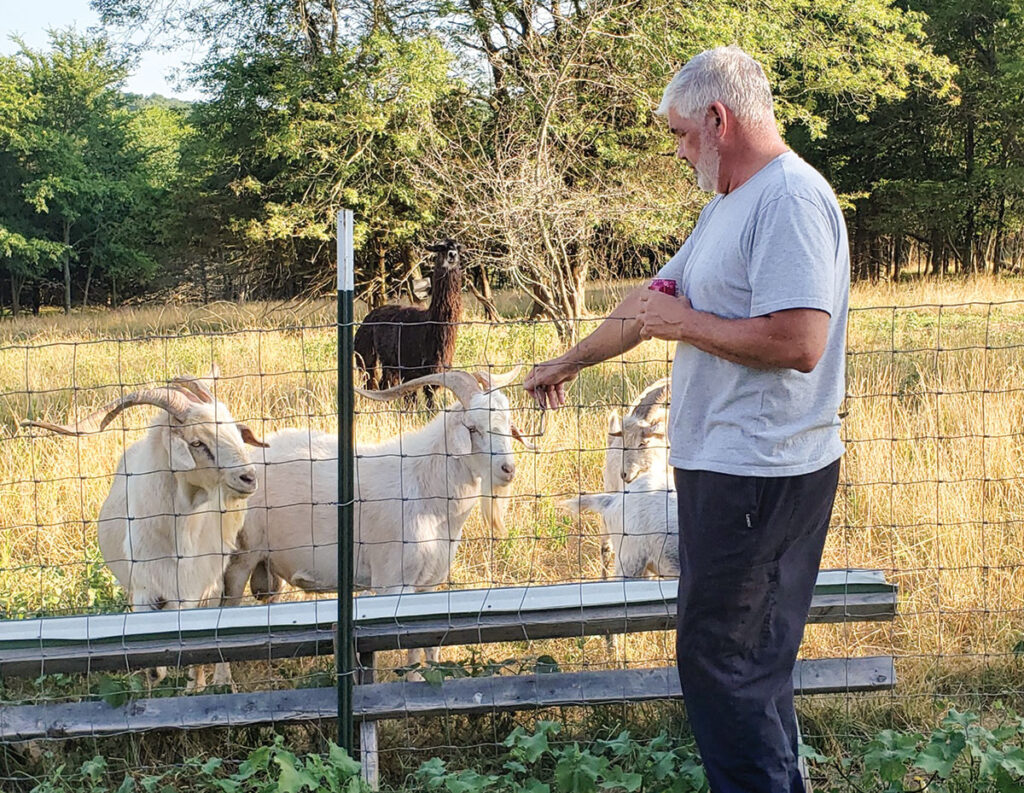
Gary Pearson has developed efficient methods of herd and flock management
NOEL, MO. – Gary Pearson, owner of GMP Farm, grew up in Santa Barbara, Calif., and considers himself a Jack-of-All-Trades.
He has been a mechanic, fuel service truck driver, welder/machinist, salesman and manager for a large equipment company mining gold in Nevada.
“When I served in the Marines and was stationed in Japan, we would share pictures of where we were from,” Gary recalls. “This guy shared pictures of Missouri, and it was the most beautiful thing I had seen. Snow glistening on branches as the sun was going down. I always remembered that.”
Moving to Northwest Arkansas 20-plus years ago, he continued in the mechanical field, working for Caterpillar and others while purchasing houses for resale. Reflecting on a conversation with a woman he described as a “hippie” who said, “Just go with what comes your way.” And that is what he has done, forward movement in all areas of his life.
One day he decided he was done and took a complete turn in his career, obtaining a bachelor’s degree in nursing.
“I am a people person, and my mom was a nurse,” he said. “I wanted to do something to serve others.”
The move to rural Missouri was a leap of faith. “I would have never in my life at my age imagined myself living this kind of life out here,” Gary said.
Purchasing a log home on 40 acres in rural McDonald County, Mo., seemed another direction change for the California native. There was a lot of underbrush and scrub to control; then he heard about goats.
Having no farm experience to draw from, he dove into research on goats, grazing, pasture management, and what animals are best suited for the geography of the Ozarks.
“Fencing is your first line of defense in keeping predators away from your animals,” he said. “Then I took a grazing class through Crowder College to learn how to rotate the herds to take advantage of the pasture I have.”
Thus, began his dive into animal husbandry and raising registered Kiko goats and Barbado Black Bellied sheep.
Kiko goats come from New Zealand and are known for being hardy and parasite-resistant with excellent maternal traits.
“My uncle used to be a farrier and always said, ‘It costs as much to raise a good horse as it does a bad horse so raise a good horse.’ So, I decided to raise all pedigree goats and sheep,” he continued.
With this in mind, he is able to meet different needs within the goat market; breeding stock, meat, show animals or pets.
“Making the best use of my time and putting forth the effort to design a process to do that is the goal.”
— Gary Pearson
As he gained more knowledge of goats and their particular maintenance needs, he began to look into a companion animal that would complement the goats grazing habits with a different set of habits, particularly in parasite tolerance.
A natural companion to goats are sheep which eat close to the ground, whereas goats are more browsers and eat things above ground level. He opted for the low-maintenance Barbados Black Belly sheep because of their strong resistance to heat and parasites.
Gary developed a strategy of running the goats in paddocks where the grass is very tall and removing them when the grass reaches about 6 inches. The sheep follow behind to graze it down and ingest any parasites unsavory to the goats. He rounds the animals up three times a year for routine checks and worming when necessary.
His passion for research and analysis allowed him to develop the most efficient methods in handling and keeping his animals healthy while reducing hands-on time. Simple things, such as multiple paddocks, automatic waterers, electric fence, portable bins and mobile chutes are time savers.
“Making the best use of my time and putting forth the effort to design a process to do that is the goal,” Gary states. “I essentially work three jobs, and I am very busy.”
This year he bred 40 does, resulting in 80 kids and about 20 ewes dropping about 40 lambs, totaling more than 100 young animals. Quads were born to a couple of his ewes in the last couple of years.
His fondness for research allows him to be proactive when situations arise. For example, one of his does displayed weakness in her rear legs. He diagnosed the symptoms and verified with his own microscope that it was Meningeal worms, more commonly known as the “deer worm” or “brain worm.” He immediately treated the animal, and she recovered in time to give birth.
He keeps his standards high when culling his stock to ensure the quality and reputation of his animals. A self-described data fanatic, he measures weights throughout the breeding and birthing cycles of the does, looking for a minimum body condition score of three. If a doe weans her weight in offspring, that is the female he keeps.
“I put all my emphasis on my does because you can always find a good buck,” he said. “I just keep the best of the best of the best.”







